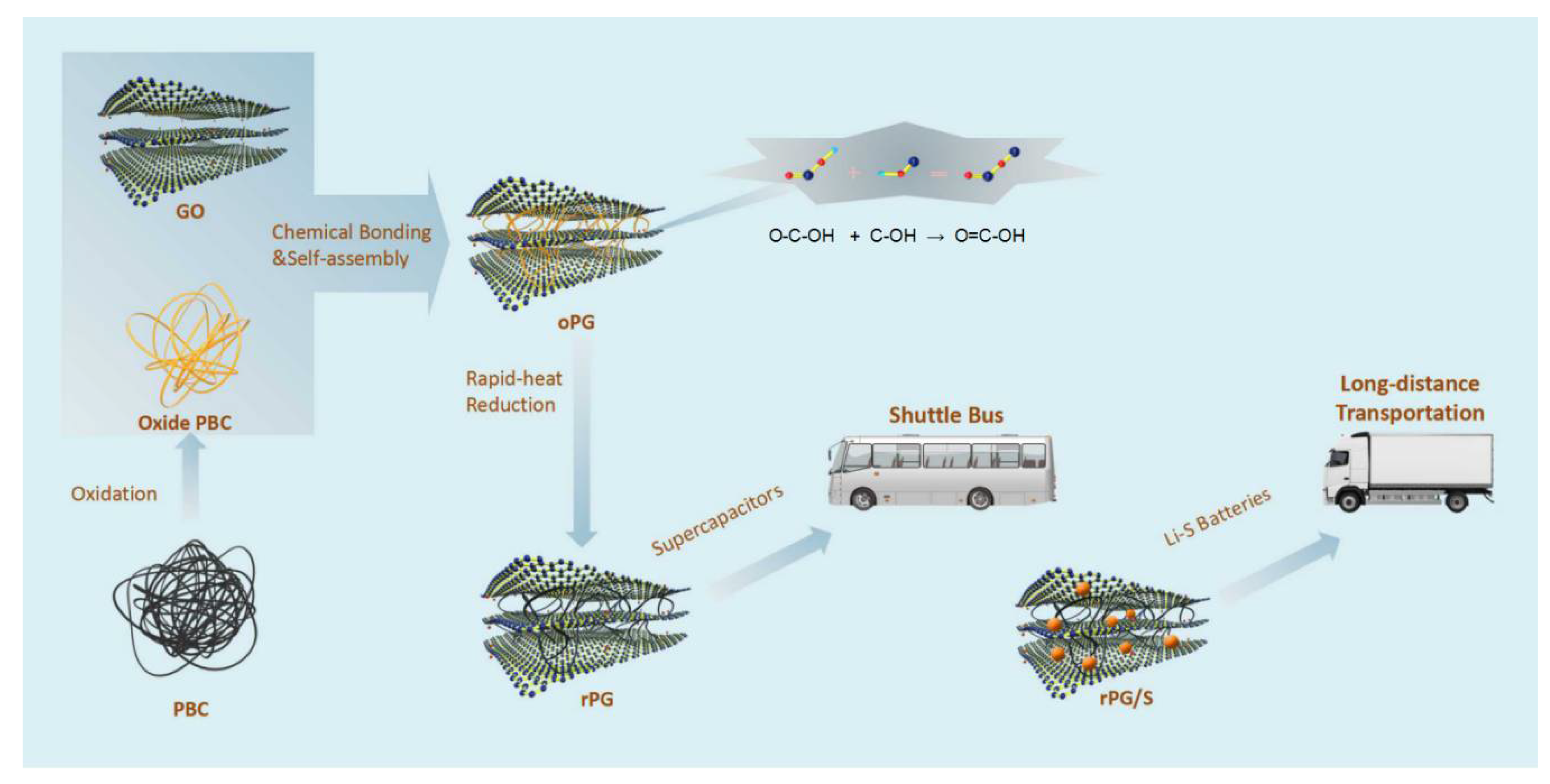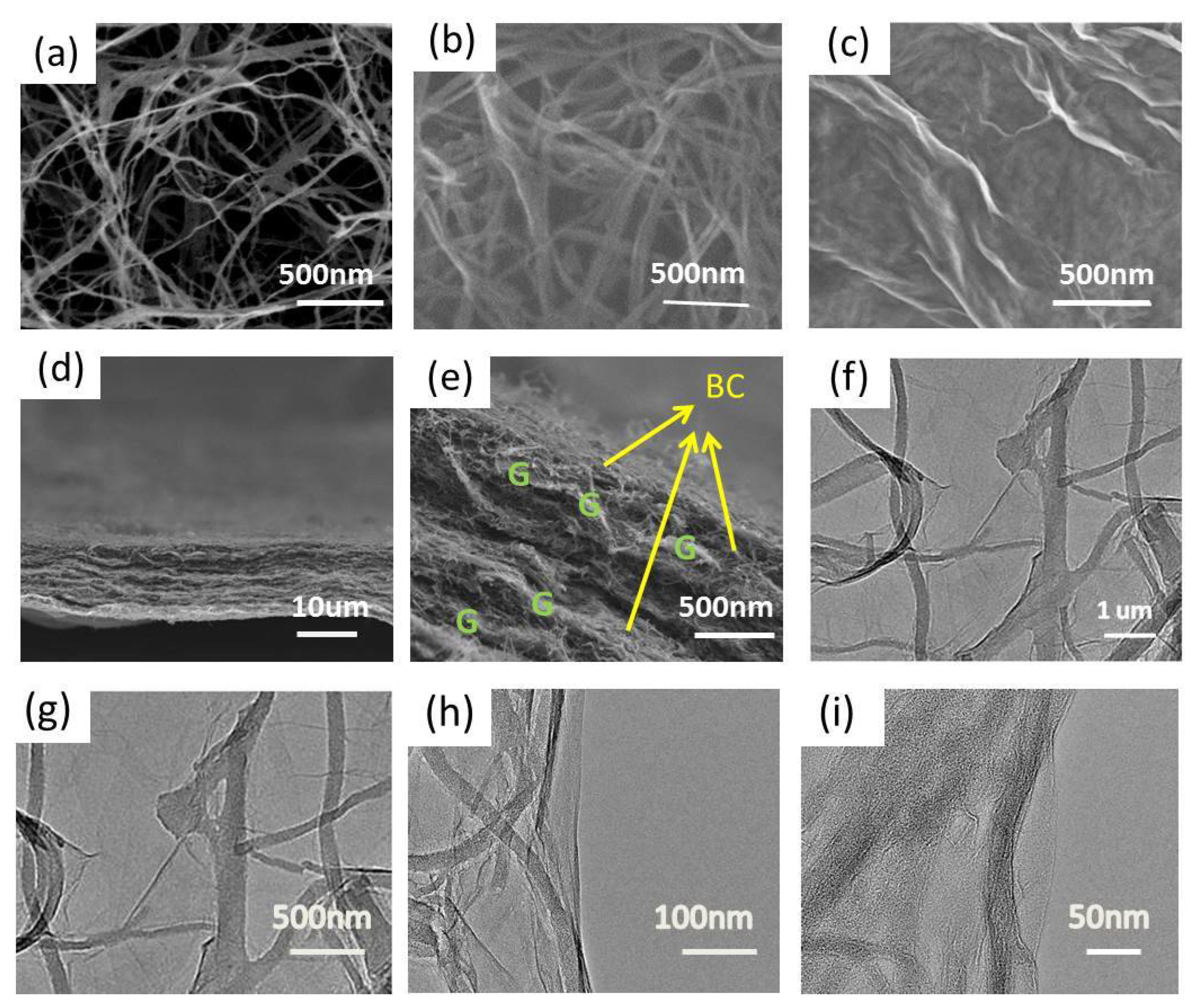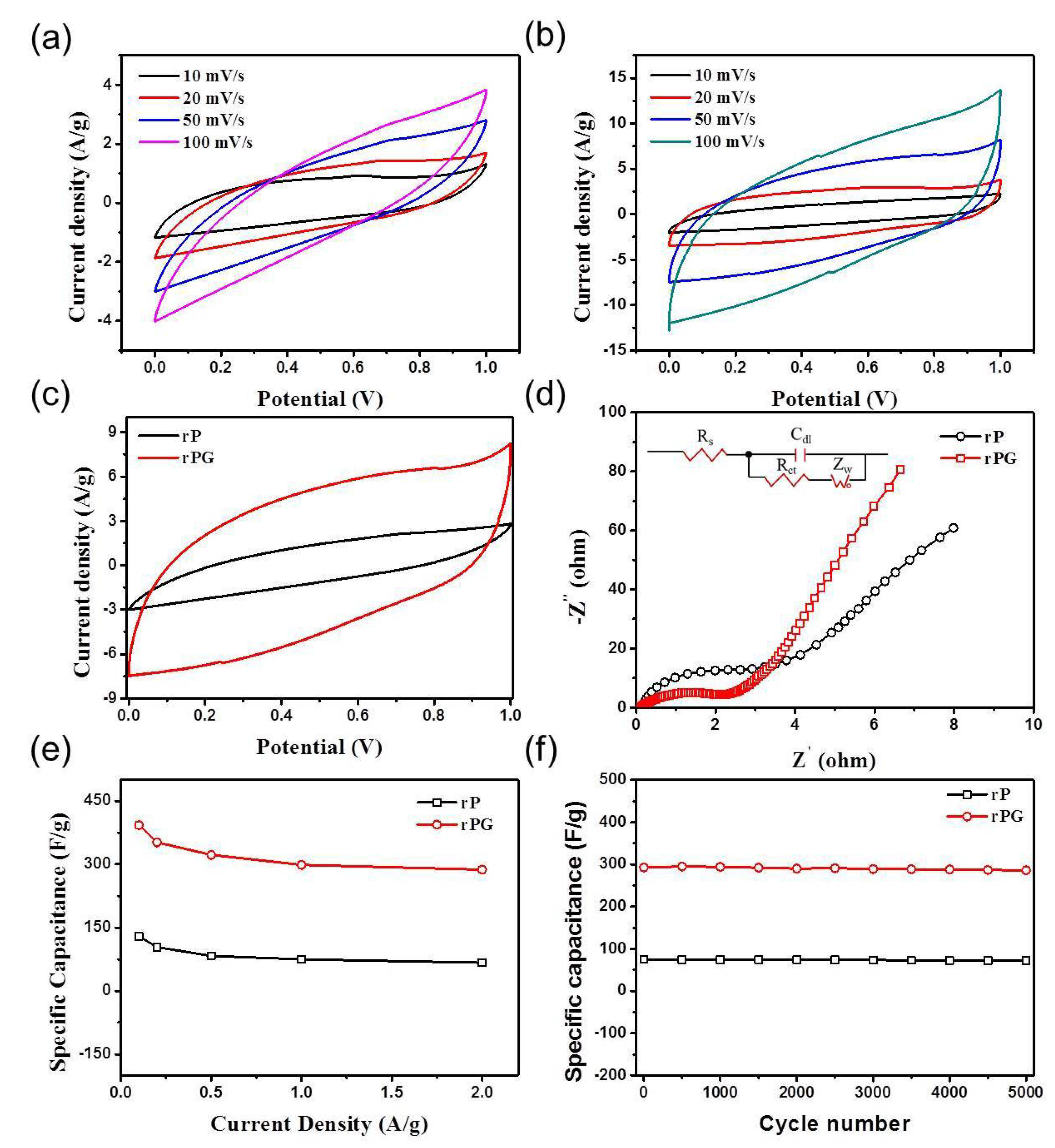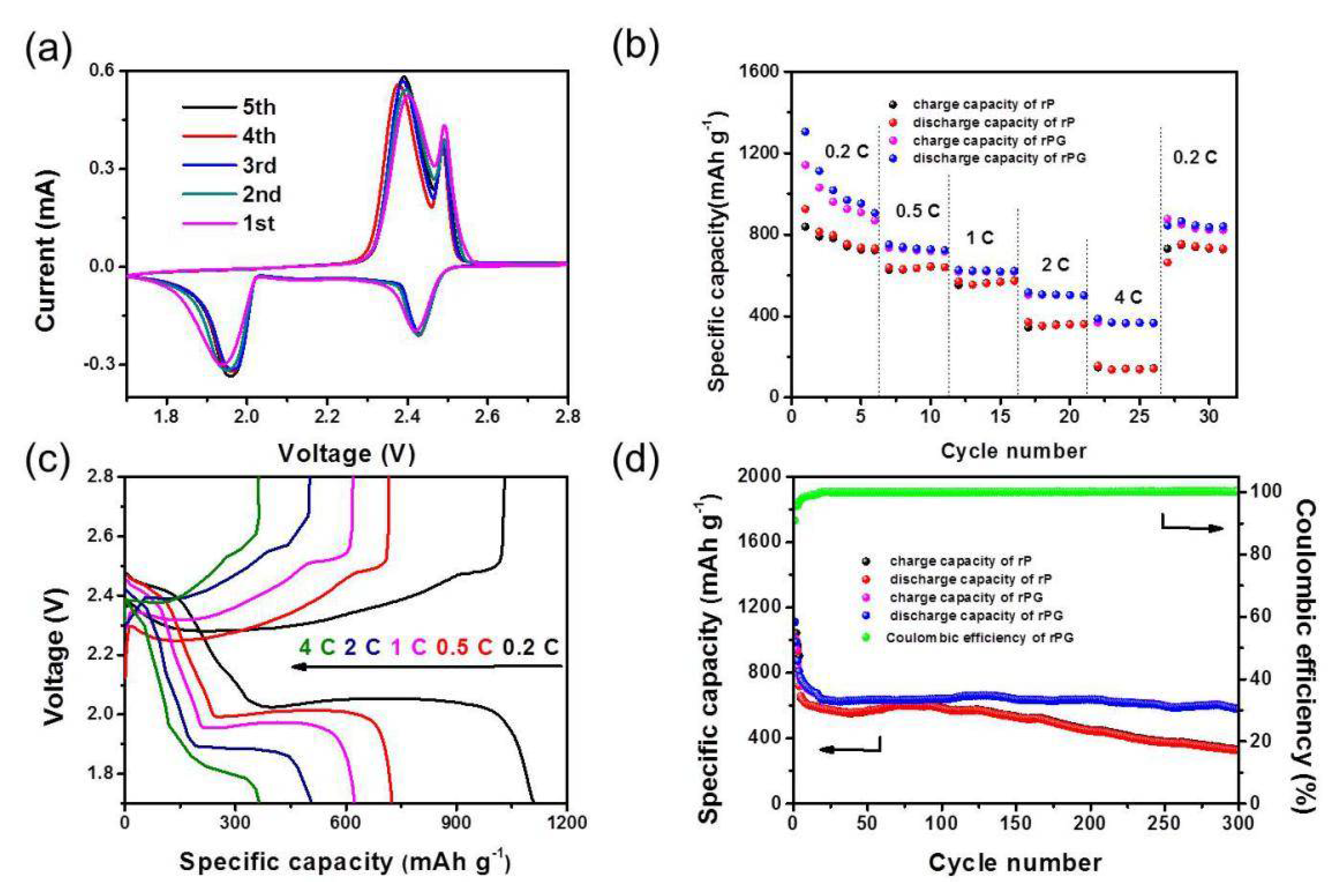Chemically Induced Compatible Interface in Pyrolyzed Bacterial Cellulose/Graphene Sandwich for Electrochemical Energy Storage
Abstract
:1. Introduction
2. Materials and Methods
2.1. Materials
2.2. Characterization of Materials
2.3. Electrochemical Performance
3. Results and Discussion
3.1. Characterization of PBC, rP and rPG
3.2. Electrochemical Characteristics of rP and rPG
3.2.1. Supercapacitors
3.2.2. Li-S Batteries
4. Conclusions
Supplementary Materials
Author Contributions
Funding
Acknowledgments
Conflicts of Interest
References
- Elsaidy, A.; Majcherkiewicz, J.N.; Puértolas, B.; Salgueiriño, V.; Nóvoa, X.R.; Correa-Duarte, M.A. Synergistic Interaction of Clusters of Iron Oxide Nanoparticles and Reduced Graphene Oxide for High Supercapacitor Performance. Nanomaterials 2022, 12, 2695. [Google Scholar] [CrossRef] [PubMed]
- Luo, X.; Yang, Q.; Dong, Y.; Huang, X.; Kong, D.; Wang, B.; Liu, H.; Xiao, Z.; Zhi, L. Maximizing pore and heteroatom utilization within N,P-co-doped polypyrrole-derived carbon nanotubes for high-performance supercapacitors. J. Mater. Chem. A 2020, 8, 17558–17567. [Google Scholar] [CrossRef]
- Xiao, Z.; Han, J.; He, H.; Zhang, X.; Xiao, J.; Han, D.; Kong, D.; Wang, B.; Yang, Q.G.; Zhi, L. A template oriented one-dimensional Schiff-base polymer: Towards flexible nitrogen-enriched carbonaceous electrodes with ultrahigh electrochemical capacity. Nanoscale 2021, 13, 19210–19217. [Google Scholar] [CrossRef] [PubMed]
- Chen, C.; Qin, H.; Cong, H.; Yu, S. A Highly Stretchable and Real-Time Healable Supercapacitor. Adv. Mater. 2019, 31, 1900573. [Google Scholar] [CrossRef]
- Yang, S.; Zhang, P.; Nia, A.; Feng, X. Emerging 2D Materials Produced via Electrochemistry. Adv. Mater. 2020, 1, 1907857. [Google Scholar] [CrossRef] [PubMed]
- Cherusseri, J.; Choudhary, N.; Kumar, K.S.; Jung, Y.; Thomas, J. Recent trends in transition metal dichalcogenide based supercapacitor electrodes. Nanoscale Horiz. 2019, 4, 840–858. [Google Scholar] [CrossRef]
- Zhang, Y.; Liu, X.; Wang, S.; Li, L.; Dou, S. Bio-Nanotechnology in High-Performance Supercapacitors. Adv. Energy Mater. 2017, 7, 1700592. [Google Scholar] [CrossRef]
- Peng, S.; Fan, L.; Rao, W.; Bai, Z.; Xu, W.; Xu, J. Bacterial cellulose membranes coated by polypyrrole/copper oxide as flexible supercapacitor electrodes. J. Mater. Sci. 2017, 52, 1930–1942. [Google Scholar] [CrossRef]
- Liu, R.; Ma, L.; Niu, G.; Li, X.; Li, E.; Bai, Y.; Yuan, G. Oxygen-Deficient Bismuth Oxide/Graphene of Ultrahigh Capacitance as Advanced Flexible Anode for Asymmetric Supercapacitors. Adv. Funct. Mater. 2017, 27, 1701635. [Google Scholar] [CrossRef]
- Kang, Y.; Chun, S.; Lee, S.; Kim, B.; Kim, J.; Chung, H.; Lee, S.; Kim, W. All-solid-state flexible supercapacitors fabricated with bacterial nanocellulose papers, carbon nanotubes, and triblock-copolymer ion gels. ACS Nano 2012, 6, 6400–6406. [Google Scholar] [CrossRef]
- Chen, L.; Huang, Z.; Liang, H.; Yao, W.; Yu, Z.; Yu, S. Flexible all-solid-state high-power supercapacitor fabricated with nitrogen-doped carbon nanofiber electrode material derived from bacterial cellulose. Energy Environ. Sci. 2013, 6, 3331–3338. [Google Scholar] [CrossRef]
- Wang, H.; Bian, L.; Zhou, P.; Tang, J.; Tang, W. Core–sheath structured bacterial cellulose/polypyrrole nanocomposites with excellent conductivity as supercapacitors. J. Mater. Chem. A 2013, 1, 578–584. [Google Scholar] [CrossRef]
- Mensah, A.; Lv, P.; Narh, C.; Huang, J.; Wang, D.; Wei, Q. Sequestration of Pb (II) Ions from Aqueous Systems with Novel Green Bacterial Cellulose Graphene Oxide Composite. Materials 2019, 12, 218. [Google Scholar] [CrossRef] [PubMed]
- Wu, Z.; Liang, H.; Chen, L.; Hu, B.; Yu, S. Bacterial Cellulose: A Robust Platform for Design of Three Dimensional Carbon-Based Functional Nanomaterials. Acc. Chem. Res. 2016, 49, 96–105. [Google Scholar] [CrossRef]
- Shen, Y.; Xiao, Z.; Miao, L.; Kong, D.; Zheng, X.; Chang, Y.; Zhi, L. Pyrolyzed bacterial cellulose/graphene oxide sandwich interlayer for lithium–sulfur batteries. Rare Metals. 2017, 5, 418–424. [Google Scholar] [CrossRef]
- Kamedulski, P.; Lukaszewicz, J.P.; Witczak, L.; Szroeder, P.; Ziolkowski, P. The Importance of Structural Factors for the Electrochemical Performance of Graphene/Carbon Nanotube/Melamine Powders towards the Catalytic Activity of Oxygen Reduction Reaction. Materials 2021, 14, 2448. [Google Scholar] [CrossRef]
- Gerasimenko, A.Y.; Kuksin, A.V.; Shaman, Y.P.; Kitsyuk, E.P.; Fedorova, Y.O.; Murashko, D.T.; Shamanaev, A.A.; Eganova, E.M.; Sysa, A.V.; Savelyev, M.S.; et al. Hybrid Carbon Nanotubes–Graphene Nanostructures: Modeling, Formation, Characterization. Nanomaterials 2022, 12, 2812. [Google Scholar] [CrossRef] [PubMed]
- Huo, Y.; Wang, B.; Nie, A.; Mu, C.; Xiang, J.; Zhai, K.; Xue, T.; Wen, F. Flexible Aramid Nanofiber/Bacterial Cellulose/Graphene Papers with Nickel Nanoparticles for Enhanced Electromagnetic Interference Shielding and Joule Heating Performance. ACS Appl. Nano Mater. 2022, 5, 5589–5598. [Google Scholar] [CrossRef]
- Miroshnikov, M.; Mahankali, K.; Thangavel, N.K.; Satapathy, S.; Arava, L.M.; Ajayan, P.M.; John, G. Front Cover: Bioderived Molecular Electrodes for Next-Generation Energy-Storage Materials. ChemSusChem 2020, 13, 2186–2204. [Google Scholar] [CrossRef]
- Kato, K.; Puthirath, A.B.; Mojibpour, A.; Miroshnikov, M.; Satapathy, S.; Thangavel, N.K.; Mahankali, K.; Dong, L.; Arava, L.M.; John, G.; et al. Light-Assisted Rechargeable Lithium Batteries: Organic Molecules for Simultaneous Energy Harvesting and Storage. Nano Lett. 2021, 21, 907–913. [Google Scholar] [CrossRef]
- Liu, Y.; Zhou, J.; Tang, J.; Tang, W. Three-Dimensional, Chemically Bonded Polypyrrole/Bacterial Cellulose/Graphene Composites for High-Performance Supercapacitors. Chem. Mater. 2015, 27, 7034–7041. [Google Scholar] [CrossRef]
- Ma, L.; Liu, R.; Niu, H.; Wang, F.; Liu, L.; Huang, Y. Freestanding conductive film based on polypyrrole/bacterial cellulose/graphene paper for flexible supercapacitor: Large areal mass exhibits excellent areal capacitance. Electrochim. Acta. 2016, 222, 429–437. [Google Scholar] [CrossRef]
- Ávila-Brande, D.; Arenas-Esteban, D.; Otero-Díaz, L.C.; Guerrero-Martínez, A.; Tardajos, G.; Carretero-González, J. Activated nanoporous carbon–gold nanoparticle composite electrode with enhanced volumetric capacitance. RSC Adv. 2015, 5, 86282–86290. [Google Scholar] [CrossRef]
- Yao, H.; Zheng, G.; Li, W.; McDowell, M.T.; Seh, Z.; Liu, N.; Lu, Z.; Cui, Y. Crab shells as sustainable templates from nature for nanostructured battery electrodes. Nano Lett. 2013, 13, 3385–3390. [Google Scholar] [CrossRef] [PubMed]
- Yao, J.; Ji, P.; Sheng, N.; Guan, F.; Zhang, M.; Wang, B.; Chen, S.; Wang, H. Hierarchical core-sheath polypyrrole@carbon nanotube/bacterial cellulose macrofibers with high electrochemical performance for all-solid-state supercapacitors. Electrochim. Acta. 2018, 283, 1578–1588. [Google Scholar] [CrossRef]
- Bu, Y.; Cao, M.; Jiang, Y.; Gao, L.; Shi, Z.; Xiao, X. Ultra-thin bacterial cellulose/poly(ethylenedioxythiophene) nanofibers paper electrodes for all-solid-state flexible supercapacitors. Electrochim. Acta. 2018, 271, 624–631. [Google Scholar] [CrossRef]
- Wang, X.; Kong, D.; Zhang, Y.; Wang, B.; Li, X.; Qiu, T.; Song, Q.; Ning, J.; Song, Y.; Zhi, L. All-biomaterial supercapacitor derived from bacterial cellulose. Nanoscale 2016, 8, 9146–9150. [Google Scholar] [CrossRef]
- Luo, H.; Xie, J.; Wang, J.; Yao, F.; Yang, Z.; Wan, Y. Step-by-step self-assembly of 2D few-layer reduced graphene oxide into 3D architecture of bacterial cellulose for a robust, ultralight, and recyclable all-carbon absorbent. Carbon 2018, 139, 824–832. [Google Scholar] [CrossRef]
- Dong, S.; He, X.; Zhang, H.; Xie, X.; Yu, M.; Yu, C.; Xiao, N.; Qiu, J. Surface modification of biomass-derived hard carbon by grafting porous carbon nanosheets for high-performance supercapacitors. J. Mater. Chem. A 2018, 6, 15954–15960. [Google Scholar] [CrossRef]
- Mahfoudhi, N.; Boufi, S. Nanocellulose as a novel nanostructured adsorbent for environmental remediation: A review. Cellulose 2017, 24, 1171–1197. [Google Scholar] [CrossRef]
- Hao, X.; Wang, J.; Ding, B.; Wang, Y.; Chang, Z.; Dou, H.; Zhang, X. Bacterial-cellulose-derived interconnected meso-microporous carbon nanofiber networks as binder-free electrodes for high-performance supercapacitors. J. Power Sources. 2017, 352, 34–41. [Google Scholar] [CrossRef]
- Luo, H.; Xiong, P.; Xie, J.; Yang, Z.; Huang, Y.; Hu, J.; Wan, Y.; Xu, Y. Uniformly dispersed freestanding carbon nanofiber/graphene electrodes made by a scalable biological method for high-performance flexible supercapacitors. Adv. Funct. Mater. 2018, 28, 1803075. [Google Scholar] [CrossRef]
- Wu, Z.; Li, C.; Liang, H.; Chen, J.; Yu, S. Ultralight, Flexible, and Fire-Resistant Carbon Nanofiber Aerogels from Bacterial Cellulose. Angew. Chem. Int. Ed. 2013, 52, 2925–2929. [Google Scholar] [CrossRef] [PubMed]
- Štefelová, J.; Slovák, V.; Siqueira, G.; Olsson, R.T.; Tingaut, P.; Zimmermann, T.; Sehaqui, H. Drying and Pyrolysis of Cellulose Nanofibers from Wood, Bacteria, and Algae for Char Application in Oil Absorption and Dye Adsorption. ACS Sustain. Chem. Eng. 2017, 5, 2679–2692. [Google Scholar] [CrossRef]
- Wang, B.; Li, X.; Luo, B.; Yang, J.; Wang, X.; Song, Q.; Chen, S.; Zhi, L. Pyrolyzed bacterial cellulose: A versatile support for lithium ion battery anode materials. Small 2013, 9, 2399–2404. [Google Scholar] [CrossRef] [PubMed]
- Fang, Y.; Luo, B.; Jia, Y.; Li, X.; Wang, B.; Song, Q.; Kang, F.; Zhi, L. Renewing Functionalized Graphene as Electrodes for High-Performance Supercapacitors. Adv. Mater. 2012, 24, 6348–6355. [Google Scholar] [CrossRef]
- Alwarappan, S.; Liu, C.; Kumar, A.; Li, C. Enzyme-doped Graphene sheets for Enhanced Glucose Biosensing. J. Phys. Chem. C 2010, 114, 12920–12924. [Google Scholar] [CrossRef]
- Iplak, Z.; Yildiz, N.; Alimli, A. Investigation of Graphene/Ag Nanocomposites Synthesis Parameters for Two Different Synthesis Methods. Fuller. Sci. Technol. 2015, 23, 361–370. [Google Scholar]
- Bradder, P.; Ling, S.; Wang, S.; Liu, S. Dye adsorption on layered graphite oxide. J. Chem. Eng. Data 2011, 56, 138–141. [Google Scholar] [CrossRef]
- Ramesh, P.; Bhagyalakshmi, S.; Sampath, S. Preparation physicochemical and electrochemical characterization of exfoliated graphite oxide. J. Colloid Interface Sci. 2004, 274, 95–102. [Google Scholar] [CrossRef]
- Hao, L.; Li, X.; Zhi, L. Carbonaceous electrode materials for supercapacitors. Adv. Mater. 2013, 25, 3899–3904. [Google Scholar] [CrossRef] [PubMed]
- Lee, K.; Lim, J.; Lee, M.J.; Ryu, K.; Lee, H.; Kim, J.Y.; Ju, H.; Cho, H.S.; Kim, B.H.; Hatzell, M.C.; et al. Structure-controlled graphene electrocatalysts for high-performance H2O2 production. Energy Environ. Sci. 2022, 15, 2858–2866. [Google Scholar] [CrossRef]
- Zhang, Z.; Zhang, J.; Zhao, X.; Yang, F. Core-sheath structured porous carbon nanofiber composite anode material derived from bacterial celllulose/polypyrrole as an anode for sodium-ion batteries. Carbon 2015, 95, 552–559. [Google Scholar] [CrossRef]
- Conway, B.E. Electrochemical Supercapacitors; Kluwer Academic/Plenum Publishers: New York, NY, USA, 1999; pp. 125–168. [Google Scholar]





Publisher’s Note: MDPI stays neutral with regard to jurisdictional claims in published maps and institutional affiliations. |
© 2022 by the authors. Licensee MDPI, Basel, Switzerland. This article is an open access article distributed under the terms and conditions of the Creative Commons Attribution (CC BY) license (https://creativecommons.org/licenses/by/4.0/).
Share and Cite
Wang, X.; Xiao, Z.; Zhang, X.; Kong, D.; Wang, B.; Wu, P.; Song, Y.; Zhi, L. Chemically Induced Compatible Interface in Pyrolyzed Bacterial Cellulose/Graphene Sandwich for Electrochemical Energy Storage. Materials 2022, 15, 6709. https://doi.org/10.3390/ma15196709
Wang X, Xiao Z, Zhang X, Kong D, Wang B, Wu P, Song Y, Zhi L. Chemically Induced Compatible Interface in Pyrolyzed Bacterial Cellulose/Graphene Sandwich for Electrochemical Energy Storage. Materials. 2022; 15(19):6709. https://doi.org/10.3390/ma15196709
Chicago/Turabian StyleWang, Xiangjun, Zhichang Xiao, Xinghao Zhang, Debin Kong, Bin Wang, Peng Wu, Yan Song, and Linjie Zhi. 2022. "Chemically Induced Compatible Interface in Pyrolyzed Bacterial Cellulose/Graphene Sandwich for Electrochemical Energy Storage" Materials 15, no. 19: 6709. https://doi.org/10.3390/ma15196709
APA StyleWang, X., Xiao, Z., Zhang, X., Kong, D., Wang, B., Wu, P., Song, Y., & Zhi, L. (2022). Chemically Induced Compatible Interface in Pyrolyzed Bacterial Cellulose/Graphene Sandwich for Electrochemical Energy Storage. Materials, 15(19), 6709. https://doi.org/10.3390/ma15196709









